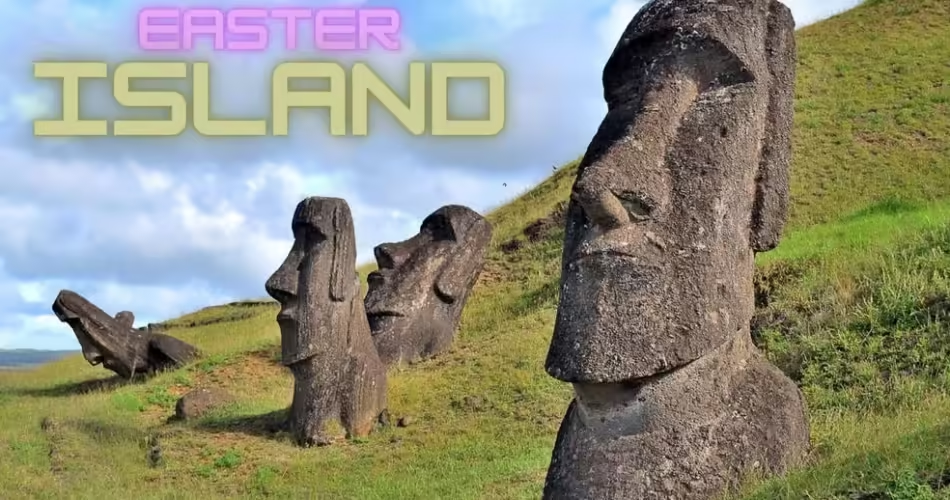This blog provide information about Easter Island. In the start, we discuss about Easter Island and its location. Then it introduces the Easter Island in detail. After that, it talks about Mystery of Moai Statues. It also discuss the Early settlement and Legends. It also discuss, Cultural Phases of Easter Island. And in the end, it tells why Easter Island Collapse and What are the lessons to learn. This blog contains History and Theory of Easter Island.
What is Easter Island?
Let’s delve into the captivating world of Easter Island, also known as Rapa Nui. This remote volcanic island, situated in the south-eastern Pacific Ocean, there is a 5.5 hours flight from Chile to reach Easter Island. This Island has an intriguing history and unique cultural heritage. Buckle up for a journey through time and mystery!
Introduction to Easter Island:
● Location:
Easter Island covers approximately 64 square miles and lies about 2,300 miles off Chile’s west coast and 2,500 miles east of Tahiti.
● Origins:
Its earliest inhabitants called it Rapa Nui. Dutch explorers reached this island in 17th century and named it Easter Island in honor of their arrival on Easter Sunday in 1722.
● Annexation:
Chile annexed the island in the late 19th century, and today, its economy thrives mainly on tourism. Tourist feel amaze to see ancient statues found of Easter Island and are stuns after knowing the history and collapse.
Mystery of Moai Statues:
The island’s most dramatic feature is its collection of nearly 900 giant stone figures. These statues, that we call as moai, were crafted by master craftsmen and engineers centuries ago. These statues are amazingly huge and most of them are at the shore of Easter Island. Tourist visit Easter Island just to see these statues because these are historical leftovers of ancient civilization.
● Materials and Placement:
Carved from tuff, a light, porous rock formed by volcanic ash, these moai stand an impressive 13 feet (4 meters) high and weigh around 13 tons. They were put atop ceremonial stone platforms that people call Ahus and so they are build with delicacy and all resembles with each other.
● Purpose and Mystery:
The exact purpose of these statues remains a mystery.
Were they representations of deified ancestors?
Guardians?
Or symbols of power?
Scholars continue to speculate and there is no answer that can be called as scientifically correct. This is a mystery from 17th century till now.

Early Settlements and Legends:
Easter Island was once an unknown island in the middle of the ocean and nobody knows its existence. Then one day people arrived and started their civilization here.
● Arrival:
The first human settlers arrived on Rapa Nui around 700-800 A.D. (according to archaeology) or possibly around 400 A.D. (according to linguists). No one had idea about this habitable island in the Pacific before a time in history. But there are different theories about the time when man arrived Easter Island.
● Hoto-Matua:
Tradition holds that the island’s first king was Hoto-Matua, who sailed from a distant Polynesian subgroup (perhaps the Marquesas Islands) and so landed at Anakena, one of the few sandy beaches on the rocky coast. This started the civilization of Easter island and it was prosperous and full of resources.
Cultural Phases of Easter Island:
By looking at the different fossils and distinct features of Easter Island so it is obvious that its cultural phases changed with passing time. Lets have a look on its cultural phases!
● Early Period (700-850 A.D.):
During this phase, early statues were deliberately destroyed and rebuilt as the larger, heavier moai. This was a part of their cultural activities.
● Middle Period (1050-1680):
Ahus now contained burial chambers, and so moai represented important figures deified after death. They used these statues as tributes and remembering of important personalities after their death.
● Late Period (post-1680):
The island’s culture continued to evolve. This was the best time of the cultural history of Easter Island.
Why did Easter Island Collapse?
Evidently, the society collapsed in just a few decades, prob-ably as a result of degradation of the island’s limited resource base. As the human population of the island increased, more and more land was cleared for agriculture, while remaining trees were used for fuel and for moving the statues into place. Previously, the soils were protected beneath the forest cover and held water in the subtropical environment. Soil nutrients were probably supplied by dust from thousands of kilometers away that reached the island on the winds. Once the forest clears, the soils erodes and the agricultural base of the society was diminishes
Loss of the forest also results in loss of forest products necessary for building homes and boats, and, as a result, that force people to live in caves. Without boats, they could no longer rely on fish as a source of protein. As population pressure increased, wars between villages became common, as did slavery and also even cannibalism, in attempts to survive in an environment depleted of its resource base. This blog contains History and Theory of Easter Island.

Ancient Civilization of Easter Island
Easter Island and Earth (The Lesson to Learn):
Easter island theory is same as the Planet Earth’s theory and we are facing the consequences. Earth is also an isolated system and humans do not have a Planet B to migrate and live with prosperity. Easter Island was same as the Earth in old times. But with overexploitation and depletion of resources and obviously rise in population, it collapsed. In the same way if we will not work on sustainability, natural resources management, population control and renewable energy resources, the Earth’s civilization will collapse one day.
We will migrate to Mars in near future, but the life of a human will be in a bubble there and nothing will be as natural and suitable like Earth. So, the lesson to learn is that, if we will not protect our earth in every way, it will be collapsed and we won’t be able to live here with prosperity like present time. This blog contains History and Theory of Easter Island.
To learn about more topics, Click the links below:
Population Growth and Land use change


Comments